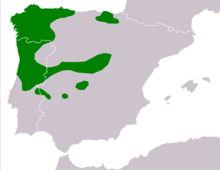Spanish frog
| Spanish frog | ||||||||||||
|---|---|---|---|---|---|---|---|---|---|---|---|---|

Spanish frog ( Rana iberica ) |
||||||||||||
| Systematics | ||||||||||||
|
||||||||||||
| Scientific name | ||||||||||||
| Rana iberica | ||||||||||||
| Boulenger , 1879 |
The Spanish frog ( Rana iberica ) is within the order of Anura to the family of Real frogs and also for species of genuine frogs . In addition, it is counted according to appearance, way of life and relationships to the complex of forms of the brown frogs . The species can only be found in the northwest of the Iberian Peninsula .
features
The Spanish frog has a body length of 30 to 70 mm, whereby the males remain smaller than the females and these also rarely reach the maximum size. It is a small and slender brown frog with a short, round snout and long legs. The back color is variable brownish, dark olive or gray with black and light, blurred spots. The ventral side is whitish with dark spots, the throat is darkly marbled with a light center line or white without a mark. The skin is smooth with distinct, widely spaced gland ridges. The webbed feet reach almost to the tips of the toes. The first and second fingers are almost the same length. The males have no vocal sacs .
When the hind leg is laid forward, the heel joint extends beyond the tip of the snout, whereby the species can be distinguished from the common frog ( R. temporaria ). The very similar species also include the Pyrenean frog ( R. pyrenaica ), which only occurs in a very small area of the Pyrenees on the Spanish-French border, and the agile frog ( R. dalmatina ).
distribution and habitat
The range of the Spanish frog is limited to the northwest of the Iberian Peninsula and is on Spanish and Portuguese territory. It occurs at heights of 100 to 2425 m (in the Sierra de Béjar in central Spain). Isolated populations are found in the Basque Country , the Spanish Central Mountains, Extremadura, and Marinha Grande and Serra de São Mamede in Portugal. Usually the habitats are characterized by annual rainfall of more than 1000 mm.
As a habitat, the frog prefers cool running waters (especially mountain streams) in open mountain forests. But it also colonizes the bank regions of various types of water within dwarf shrub formations and pasture landscapes.
Way of life
The breeding season of the Spanish frog is in the months of November to March, at higher altitudes also into April, and possibly even into July. In central Spain, spawning activities were recorded in November and December. The gelatinous spawn is deposited in small balls of 100 to 450 eggs under stones in the stream bed at night.
Danger
The Spanish frog is classified in the IUCN's Red List of Threatened Species as a type of "Near Threatened" (NT), as a significant decline of less than 30% has been noted within the last ten years. The main threat to this species comes from habitat loss, which occurs as a result of increasing habitat change through agriculture and settlement.
Legal protection status
- Fauna-Flora-Habitat Directive (FFH-RL): Annex IV (strictly protected)
- Federal Species Protection Ordinance (BArtSchV): particularly protected
Evidence cited
- ↑ a b Rana iberica in the endangered Red List species the IUCN 2007. Posted by: Tejedo, M., Bosch, J., Martinez-Solano, I., Salvador, A. García-París, M. & Gil, ER , 2004. Retrieved July 26, 2008.
literature
- Axel Kwet: Reptiles and Amphibians of Europe . Franckh'sche Verlagsbuchhandlung, Stuttgart 2005, p. 101, ISBN 3-440-10237-8
- Andreas & Christel Nöllert: The amphibians of Europe. Franckh-Kosmos, Stuttgart 1992, pp. 338-341. ISBN 3-440-06340-2
Web links
- Pictures of Rana iberica at herp.it
- Global Amphibian Assessment: Rana iberica (English; including distribution map)

